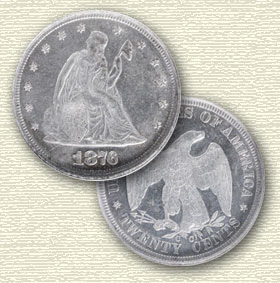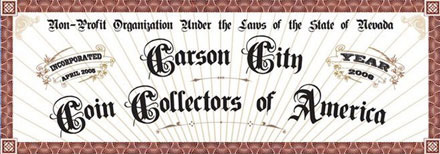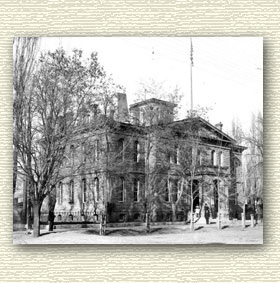1873-CC Without Arrows 25c CC Coin of the Week 12-4-11
- coindrummer
-

- Offline
- Platinum Member
-

- Michael D. Parrott
Less
More
- Posts: 775
- Thank you received: 0
12 years 5 months ago #3792
by coindrummer
C4OA Lifer!
Replied by coindrummer on topic Re:1873-CC Without Arrows 25c CC Coin of the Week 12-4-11
Hi Carsonite
A monster post such as this (1873-CC without arrows seated quarter) deserves much more than a simple "Great job on a fine post" at least in my book!
So, as I did with your other monster posts, I copied and pasted to my "word" document and saved a permanent copy to serve as my own reference point for this "Princess" issue.
I will now spend some serious time with your post...read and re-read before I attempt to issue a reply, a reply that hopefully comes close to meeting the worthiness level this superior post deserves.
I will be posting that reply within the next day or two.
the drummer
A monster post such as this (1873-CC without arrows seated quarter) deserves much more than a simple "Great job on a fine post" at least in my book!
So, as I did with your other monster posts, I copied and pasted to my "word" document and saved a permanent copy to serve as my own reference point for this "Princess" issue.
I will now spend some serious time with your post...read and re-read before I attempt to issue a reply, a reply that hopefully comes close to meeting the worthiness level this superior post deserves.
I will be posting that reply within the next day or two.
the drummer
C4OA Lifer!
Please Log in to join the conversation.
12 years 5 months ago #3798
by Belayoff
C4OA Lifer!
Replied by Belayoff on topic Re:1873-CC Without Arrows 25c CC Coin of the Week 12-4-11
Carsonite,
I've been looking forward to this article for some time and you did not disappoint.
During the approximate two year run of the Carson City Coin of the Week project, I had the honor of writing about five of the eleven coins produced by the Nevada mint in 1873. In doing so, I came to realize the size and complexity of this near inexhaustible subject. By my third or fourth article on an 1873 minted coin from Carson City, I had uncovered so much fascinating material that it became difficult to decide how to write the articles and where to end them.
I did not know that Linderman had personally tested coins from the other mints, beyond those numbers required by the coinage act (1 per 1,000 gold coins and 1 per 2,000 silver coins). Nor did I realize that the individual mints tested the coins from other branch mints, again, beyond those required by the coinage act. One doesn't need a stretch of the imagination too envision the antipathy such additional testing must have created between competing branch mints.
Furthermore, Linderman's frequent (monthly?) grab bagging of test coins must have stirred up a few emotions as well. I would bet he was not very well liked by the various coin mints' rank and file. Why test so many coins anyway? What other sly, goings-on was this fellow up to?
Linderman's seemingly hand's-on style of management flies in the face of some of the facts. Why, for instance, would he be so concerned with minute details of assay and weight measures, while at the same time, completely miss the fact that many branch mints continued to hammer out no-arrows coins after their production had technically been halted?
I've been particularly looking forward to the stories of pedigree and provenance that I knew you would provide on the handful of 1873-CC No Arrows Quarters known to exist. Here too, your knowledge and breadth of experience on this subject produced several wonderful stories, albeit, some ending with more questions than answers.
One fact I find particularly intriguing is the condition of the lowest graded of the five examples. You describe the coin's surface as "rough, pitted and stained". Of these descriptions, it's the "pitted" surface condition that got my attention. Carson City coin collectors are well aware of the frequently found, rough and pitted surface qualities of many of the mint's coins. There are several denomination dates, particularly among the dimes, in which one almost expects to find such surfaces regardless of whether the coin is circulated or mint state. But the 1873-CC No Arrows quarter is not one of these!
Unless you decided not to report the condition of their surfaces as pitted in the three uncirculated examples and one XF piece extant, one cannot help but wonder why the fifth member of this little group is so described! Did the coin suffer some environment so harsh that the coin's surface became pitted after it was minted. If not, is it possible that the coin was made by an employee(s)sometime after 1873 from rusted dies lying around the Carson City mint? If they were trying to produce a nice example of the coin to sell or to keep for their own, they might not have had the time to thoroughly polish the rusted dies, thus a very poor copy of the 1873-CC No Arrows Quarter was the result. Disappointment with the result may have led them to simply spend the coin as normal pocket change, possibly explaining its degree of circulatory wear AND its pitted surface condition. I so love a mystery...even if I have to make one up!
Thanks sincerely for writing this fabulously informative piece on the Princess of Carson City ultra rarities.
Belay Off
I've been looking forward to this article for some time and you did not disappoint.
During the approximate two year run of the Carson City Coin of the Week project, I had the honor of writing about five of the eleven coins produced by the Nevada mint in 1873. In doing so, I came to realize the size and complexity of this near inexhaustible subject. By my third or fourth article on an 1873 minted coin from Carson City, I had uncovered so much fascinating material that it became difficult to decide how to write the articles and where to end them.
I did not know that Linderman had personally tested coins from the other mints, beyond those numbers required by the coinage act (1 per 1,000 gold coins and 1 per 2,000 silver coins). Nor did I realize that the individual mints tested the coins from other branch mints, again, beyond those required by the coinage act. One doesn't need a stretch of the imagination too envision the antipathy such additional testing must have created between competing branch mints.
Furthermore, Linderman's frequent (monthly?) grab bagging of test coins must have stirred up a few emotions as well. I would bet he was not very well liked by the various coin mints' rank and file. Why test so many coins anyway? What other sly, goings-on was this fellow up to?
Linderman's seemingly hand's-on style of management flies in the face of some of the facts. Why, for instance, would he be so concerned with minute details of assay and weight measures, while at the same time, completely miss the fact that many branch mints continued to hammer out no-arrows coins after their production had technically been halted?
I've been particularly looking forward to the stories of pedigree and provenance that I knew you would provide on the handful of 1873-CC No Arrows Quarters known to exist. Here too, your knowledge and breadth of experience on this subject produced several wonderful stories, albeit, some ending with more questions than answers.
One fact I find particularly intriguing is the condition of the lowest graded of the five examples. You describe the coin's surface as "rough, pitted and stained". Of these descriptions, it's the "pitted" surface condition that got my attention. Carson City coin collectors are well aware of the frequently found, rough and pitted surface qualities of many of the mint's coins. There are several denomination dates, particularly among the dimes, in which one almost expects to find such surfaces regardless of whether the coin is circulated or mint state. But the 1873-CC No Arrows quarter is not one of these!
Unless you decided not to report the condition of their surfaces as pitted in the three uncirculated examples and one XF piece extant, one cannot help but wonder why the fifth member of this little group is so described! Did the coin suffer some environment so harsh that the coin's surface became pitted after it was minted. If not, is it possible that the coin was made by an employee(s)sometime after 1873 from rusted dies lying around the Carson City mint? If they were trying to produce a nice example of the coin to sell or to keep for their own, they might not have had the time to thoroughly polish the rusted dies, thus a very poor copy of the 1873-CC No Arrows Quarter was the result. Disappointment with the result may have led them to simply spend the coin as normal pocket change, possibly explaining its degree of circulatory wear AND its pitted surface condition. I so love a mystery...even if I have to make one up!
Thanks sincerely for writing this fabulously informative piece on the Princess of Carson City ultra rarities.
Belay Off
C4OA Lifer!
Please Log in to join the conversation.
12 years 5 months ago - 12 years 5 months ago #3799
by Garryn
Replied by Garryn on topic Re:1873-CC Without Arrows 25c CC Coin of the Week 12-4-11
I agree with Mike, it is a monster post for a monster coin. I am glad that the Boyd specimen has been identified and placed in the Battle Born Collection. Photos of coins were few and far between in those days.
Last edit: 12 years 5 months ago by Garryn.
Please Log in to join the conversation.
12 years 5 months ago - 12 years 5 months ago #3800
by Carsonite
C4OA Lifer!
Replied by Carsonite on topic Re:1873-CC Without Arrows 25c CC Coin of the Week 12-4-11
Belay Off,
I'm glad you found a few things of interest in my article.
You asked,
Keep in mind, the term "pitting" refers to the surfaces being potholed or pockmarked. The small pitlike scars appear as tiny craters on the coin's surfaces. They are incuse as opposed to being in low relief.
The condition you referred to when you wrote,
The "pitted" 1873-CC Without Arrows quarter with rough surfaces, at one time looked just like the other three Mint State examples extant (Without the toning of course). Because of where it was buried (in the ground or in the water), or perhaps because of being saved from a fire, the environmental damage caused the surfaces to look like a crater-layered moon.
I hope this satisfies your curious mind.
Thanks again for your commendatory review of my article.
Rusty
I'm glad you found a few things of interest in my article.
You asked,
The answer is yes, the pitting and staining is from environmental damage. The coin has the same characteristics as silver pieces found buried in the ground or under water.Did the coin suffer some environment so harsh that the coin's surface became pitted after it was minted.
Keep in mind, the term "pitting" refers to the surfaces being potholed or pockmarked. The small pitlike scars appear as tiny craters on the coin's surfaces. They are incuse as opposed to being in low relief.
The condition you referred to when you wrote,
is a result of using rusted dies, which produced pimply surfaces, or small bumps or nubs that protrude above the surfaces. In other words, the signs of rusted dies are in low relief.Carson City coin collectors are well aware of the frequently found, rough and pitted surface qualities of many of the mint's coins. There are several denomination dates, particularly among the dimes,
The "pitted" 1873-CC Without Arrows quarter with rough surfaces, at one time looked just like the other three Mint State examples extant (Without the toning of course). Because of where it was buried (in the ground or in the water), or perhaps because of being saved from a fire, the environmental damage caused the surfaces to look like a crater-layered moon.
I hope this satisfies your curious mind.
Thanks again for your commendatory review of my article.
Rusty
C4OA Lifer!
Last edit: 12 years 5 months ago by Carsonite. Reason: Line spacing
Please Log in to join the conversation.
12 years 5 months ago #3801
by Carsonite
C4OA Lifer!
Replied by Carsonite on topic Re:1873-CC Without Arrows 25c CC Coin of the Week 12-4-11
GarryN,
Thanks for your favorable reply.
Rusty
Thanks for your favorable reply.
Rusty
C4OA Lifer!
Please Log in to join the conversation.
Time to create page: 0.224 seconds


